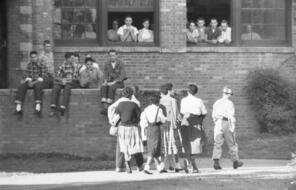
The Persistence of Racial Segregation in American Schools
At a Glance
Language
English — USSubject
- Civics & Citizenship
- Social Studies
Grade
6–12- Racism
Overview
About This Mini-Lesson
This mini-lesson provides two core activities, which give students an overview of school segregation in the United States today and open a discussion about possible responses to school segregation, as well as four extension activities, each of which explores a more specific topic relating to school segregation. Use the activities most relevant to your students or school.
Activities
Activities
Extension Activities
Materials and Downloads
Resources from Other Organizations
Additional Resources
Unlimited Access to Learning. More Added Every Month.
Facing History & Ourselves is designed for educators who want to help students explore identity, think critically, grow emotionally, act ethically, and participate in civic life. It’s hard work, so we’ve developed some go-to professional learning opportunities to help you along the way.
Exploring ELA Text Selection with Julia Torres
On-Demand

Working for Justice, Equity and Civic Agency in Our Schools: A Conversation with Clint Smith
On-Demand

Centering Student Voices to Build Community and Agency
On-Demand















